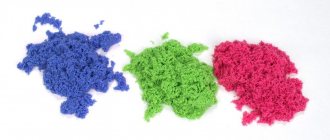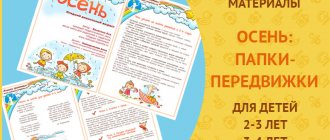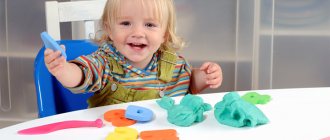Project “Playing with sand during the period of adaptation to preschool education”
Project type: practice-oriented.
Project duration: short-term (5 months).
Project implementation period: August – December 2018.
According to the number of project participants: group.
Project participants: pupils and teachers of early age groups, educational psychologist.
Project goal: successful adaptation of young children in a kindergarten through the use of sand games.
Tasks:
- reduce the level of anxiety in children during the period of adaptation to new conditions;
- motivate educators to use sand play when working with children during the adaptation period;
- contribute to increasing the psychological and pedagogical competence of educators.
Expected results:
- favorable course of the process of adaptation to new conditions with positive results;
- establishing trusting relationships between teachers and children;
- increasing the level of professional competence of educators in organizing the adaptation period.
Product of the project activity: a card index of sand games for working with young children.
Relevance
When a child enters kindergarten, a new stage in his life begins. Separation from home and loved ones, meeting new adults and unfamiliar peers becomes a serious mental trauma for the child. During the adaptation period, a restructuring of the previously formed dynamic stereotype, physiology and immune system occurs. A stressful situation causes a protective reaction of the body in the form of refusal to sleep, eat, or communicate with others. In this regard, the adaptation period enters a difficult stage, which is characterized by various fluctuations in the somatic state and mental status, which leads to weight loss, frequent respiratory diseases, sleep disturbances, decreased appetite, regression in speech development, neuroses, nervous system breakdowns, etc. .P.
One of the methods that helps a child painlessly adapt to kindergarten during the adaptation period is playing with sand.
The sandbox is an excellent mediator for establishing contact between the teacher and the child. Playing with sand reduces the level of mental stress of both the child and the teacher, who, in turn, also experiences nervous overload during this period. And this leads to a reduction in adaptation time.
Project implementation stages:
Stage 1. Preparatory
- Selection and study of literature.
- Drawing up an activity plan.
- Selection of sand games for working with young children.
- Selection and development of materials for working with teachers.
Stage 2. Basic
| Events | Responsible | Deadlines |
| Consultation for educators “Possibilities of using sand games during the period of children’s adaptation to preschool educational institutions” | Educational psychologist | August |
| Master class for educators “Playing with sand at an early age” | Educational psychologist | August |
| Development of a card index of sand games for young children. | Educational psychologist | August |
| Organization of RPPS: technical equipment for playing with sand in early age groups. | Educators, preschool administration | August |
| Using sand games when working with children. | Early childhood educators | August – December |
| Observation of children in adaptation groups. | Educational psychologist | August – December |
| Individual lessons with children experiencing difficulties in adaptation using the sand therapy method. | Educational psychologist | Of necessity |
| Individual counseling for educators. | Educational psychologist | On request |
Stage 3. Final
- Analysis of the level of adaptation of children.
- Comparison of existing results with predicted ones.
- Summarizing.
- Adjustment of work plans with adaptation groups.
Annex 1
Consultation for educators
"Possibilities of using sand games
during the period of children’s adaptation to preschool educational institutions"
When a child enters kindergarten, a new stage in his life begins. Separation from home and loved ones, meeting new adults and unfamiliar peers becomes a serious mental trauma for the child. During the adaptation period, a restructuring of the previously formed dynamic stereotype, physiology and immune system occurs. A stressful situation causes a protective reaction of the body in the form of refusal to sleep, eat, or communicate with others. In this regard, the adaptation period enters a difficult stage, which is characterized by various fluctuations in the somatic state and mental status, which leads to weight loss, frequent respiratory diseases, sleep disturbances, decreased appetite, regression in speech development, neuroses, nervous system breakdowns, etc. .P.
The sandbox is an excellent mediator for establishing contact with a child. A small child still speaks poorly and cannot tell an adult about his experiences, then in games with sand everything becomes possible. By acting out an exciting situation with the help of small figures, creating a picture out of sand, the child is freed from tension and anxiety. Adults get the opportunity to see the child’s inner world at the moment.
Playing with sand reduces the high level of mental stress of both the child and the teacher, who, in turn, also experiences nervous overload during this period. This leads to a reduction in adaptation time.
Through playing with a child in the sandbox, the teacher can unobtrusively inform him of the norms and rules of behavior in the group. The teacher naturally carries out psychological and pedagogical correction of the child’s behavior and teaches him socially acceptable methods of nervous release.
Through playing in the sand, a child’s sense of trust, acceptance and success is born or strengthened, and the following tasks are solved:
- In the sandbox, a trusting relationship between the teacher and the child is quickly established. For the child, the role of the educator becomes clear, predictable and meaningful, which strengthens his basic trust in the world.
- In sand games with miniature figures, a child, with the help of an adult, plays out the traumatic situation of separation from parents, an encounter with the unknown, and learns positive ways of behavior.
- The teacher becomes a guide for the child in mastering skills, abilities and knowledge about the world around him and himself in this world.
The following materials can be used for playing with sand:
- Sandbox “Small” (a rectangular wooden box, traditional size 50*70*8 cm).
- Sand tablet (wooden tray with a colored bottom).
- Kinetic sand.
- Living sand.
- River sand (washed, calcined river sand of coarse or fine fraction)
- Quartz sand (colored river sand of coarse or fine fraction).
- Rainbow sand.
- Sets of miniature toys (people, animals, birds, inhabitants of the aquatic world, houses, trees and other plants, vehicles, objects of the human environment, accessories - shells, stones, rolling pins, molds, scoops, buckets, etc.)
Appendix 2
Outline of the master class for educators
"Playing with sand at an early age"
Rules for playing in the sandbox for kids.
At this stage, it is advisable to introduce the child to the rules of behavior in the sandbox (the younger the children, the shorter the rules).
1. Take care of grains of sand - do not throw them out of the sandbox. If sand accidentally spills out, show it to an adult and he will help them get back into the sandbox. You cannot throw sand out of the sandbox.
2. Sand grains really don’t like being put in the mouth or thrown at other children. You cannot put sand in your mouth and throw it at other people.
3. The sand fairy loves when children have clean hands and noses. Play with the sand - wash your hands and show your clean palms to the mirror.
General recommendations for preparing and conducting adaptation games and activities:
- Classes for children are held in a group every day for 5-10 minutes.
- The number of children in the subgroup is 2-3 people, special attention is paid to the newly arrived child.
- It is advisable that in this subgroup there are children who have already adapted to life in kindergarten, since a beginner will perform many games by imitation or out of curiosity.
- When conducting the first adaptation games-sessions, it is not necessary to adhere to the rigid structure of the lesson; it is possible to extend the time of playing in the sand if this stabilizes the child’s psychophysical state well.
- During the first two or three lessons, the child is not shown the entire set of toys; he must master a fairly wide range of simple manipulations with sand using his hands, a shovel, and a brush.
- During classes, you need to carefully monitor the child’s reaction when working with sand. If a negative attitude or fatigue appears, the lesson is unobtrusively ended.
- At the beginning of the game, the methods of action are first shown, and then the child “hand in hand” or independently repeats them. You should not insist on strict adherence to instructions; the adult should initially adapt to the child.
- To begin and end games-activities, a special greeting and farewell ritual is developed (this can be certain music or sound, an hourglass, etc.)
Stages of work: (All described games are played with teachers)
1. The stage of touching and playing on the surface of dry sand.
Game "Hello, sand!" The goal is to reduce psychophysical stress. The teacher, on behalf of the fairy, asks to “gently” and then strongly greet the sand,” that is, to touch the sand in various ways:
— The child touches the sand alternately with the fingers of one, then the other hand, then with all fingers at the same time;
- The child easily/with tension squeezes his fists with sand; then slowly pours it into the sandbox;
- The child touches the sand with his entire palm - the inside, then the back;
— The child rubs sand between his fingers and palms; The sand also wants to say hello in return - to sprinkle “sand rain” on your fingers.
Game “Sand Rain” The goal is to regulate muscle tension and relaxation. Sand Fairy: “In my country there may be an unusual sand rain and a sand wind blowing. It is very nice. You can make such rain and wind yourself. Watch how it happens":
— The child slowly and then quickly pours sand from his fist into the sandbox, onto the palm of an adult, into his palm.
— The child closes his eyes and places his palm with his fingers spread out on the sand, the adult sprinkles sand on a finger (naming it), and the child repeats as much as possible. Then they change (the child sprinkles sand on the adult’s fingers and, if possible, pronounce the names of the fingers together)
Game “Unusual Traces” Goal: development of tactile sensitivity and imagination.
- “The little bear cubs are coming” - the child presses forcefully on the sand with his fists and palms;
- “Snakes are crawling” - the child makes the surface of the sand wavy with relaxed/tense fingers;
- “Hares are jumping” - the child hits the surface of the sand with his fingertips, moving in different directions;
- “Spiderbugs are running” - the child moves all his fingers, imitating the movements of insects (you can completely immerse your hands in the sand, meeting each other under the sand - “bugs say hello.”
2. The stage of touching and playing on the surface of wet sand (kinetic sand).
Game “Handprints” On a flat surface of sand, a child and an adult take turns making handprints: with the inside and outside. It is important to hold your hand on the sand, pressing it slightly, and listen to your feelings. The adult begins the game by telling the child about his feelings: “I’m pleased. I feel the coolness (or warmth) of the sand. When I move my hands, I feel small grains of sand. How do you feel?”
Game “Minks-mounds” The child makes holes in the sand with each finger in turn, then with all of them at once - a home for a mouse, and sculpts mounds - a home for a turtle.
3. Stage of educational games on the surface of the sand and with hands immersed in the sand.
Game “Sand Hide and Seek” Goal: development of tactile sensitivity, visual perception, imaginative thinking, arbitrariness. The toys want to play sand hide and seek with you. Choose the toys you like. You close your eyes, and they will hide in the sand, and after I say: “The eyes open, the game begins,” you must find them in the sand. You can blow sand, dig with your fingers, use sticks, brushes (Guess what's hidden in the sand?, Who's hiding in the sand?).
Game “Patterns on the Sand” Purpose: to consolidate knowledge about sensory standards, to establish patterns.
— An adult, using a finger, the edge of the palm, or a brush in the upper part of the sandbox, draws various geometric shapes (in accordance with age standards for development), simple/complex patterns (straight and wavy paths, fences, ladders). The child must draw the same pattern below in the sand, or continue the adult’s pattern.
— The same patterns on sand are made by laying out objects in a given sequence, for example: cones, acorns, buttons, etc.




